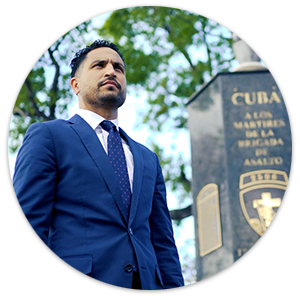When tragedy strikes, and the life of a loved one is taken due to the careless actions of another, the pain is often overwhelming. In Florida, as in many states, the law provides a legal avenue for families to seek justice and compensation for their loss through wrongful death claims. These claims, however, are not easy to prove, and one of the most crucial elements in such cases is demonstrating that the death was caused by negligence. Proving negligence in Florida wrongful death cases requires a clear understanding of the legal principles involved and the ability to present compelling evidence that supports the claim.
Richard Guzman’s expertise focuses on one primary objective: to offer tactical legal analysis, guidance, and result-driven solutions. The Guzman Firm is dedicated to providing you with the knowledgeable and competent counsel you deserve.
Attorney Richard Guzman
Understanding Wrongful Death Claims in Florida
Before diving into the intricacies of proving negligence, it is essential to have a foundational understanding of wrongful death claims in Florida. A wrongful death claim arises when a person’s death is caused by the wrongful act, negligence, default, or breach of contract or warranty of another individual or entity. In Florida, these claims are governed by the Florida Wrongful Death Act, which allows the deceased person’s estate and certain family members to pursue compensation for the loss. The law recognizes that the untimely death of a loved one can lead to a host of financial and emotional burdens, and it seeks to provide a legal remedy for the surviving family members.
The Florida Wrongful Death Act specifies that only certain individuals are eligible to file a wrongful death claim. These individuals typically include the deceased person’s spouse, children, parents, and, in some cases, other relatives who were dependent on the deceased for support or services. The personal representative of the deceased person’s estate is responsible for filing the claim on behalf of the eligible beneficiaries. The compensation sought in a wrongful death claim can cover a variety of damages, including medical and funeral expenses, loss of income, loss of companionship, and emotional suffering.
The Role of Negligence in Wrongful Death Cases
Negligence is a central element in many wrongful death cases. To succeed in a wrongful death claim, the plaintiff must demonstrate that the defendant’s negligence directly caused the death of their loved one. In legal terms, negligence occurs when an individual or entity fails to exercise the level of care that a reasonably prudent person would have exercised under similar circumstances. This failure to act with reasonable care can result in harm to others, and when it leads to death, it forms the basis of a wrongful death claim.
To establish negligence in a wrongful death case, the plaintiff must prove four key elements. These elements are duty of care, breach of duty, causation, and damages. Each of these elements plays a critical role in building a successful wrongful death claim, and the plaintiff must present convincing evidence to support each one.
“Richard is deeply invested in his community and is a professional of purpose and integrity. As our legal counsel, his strategic approach, proactive communication, and commitment to our organization’s needs and goals have helped us navigate challenges as well as build important partnerships.” “I go to Richard Guzman because of trust. He was recommended by my dear sister that had the pleasure of working with Mr. Guzman. By having a direct recommendation, I did not doubt that he could ease my worries and that I would be backed by a knowledgeable, trustworthy professional.”![]()
Dejha C.
![]()
Piero S.
Duty of Care
The first element that must be established in a wrongful death case is the existence of a duty of care. Duty of care refers to the legal obligation that an individual or entity has to act in a manner that avoids causing harm to others. This duty can arise in various contexts, depending on the relationship between the parties involved and the circumstances of the case. For example, a driver has a duty to operate their vehicle safely to avoid causing accidents, while a property owner has a duty to maintain their premises in a reasonably safe condition to prevent injuries to visitors.
In wrongful death cases, the plaintiff must demonstrate that the defendant owed a duty of care to the deceased person. This often involves showing that the defendant had a legal obligation to act in a certain way to prevent harm and that this duty was directly related to the circumstances that led to the death. The specific nature of the duty of care will vary depending on the facts of the case, but establishing its existence is a crucial first step in proving negligence.
Breach of Duty
Once the plaintiff has established that the defendant owed a duty of care to the deceased person, the next step is to prove that the defendant breached this duty. A breach of duty occurs when the defendant fails to act with the level of care that a reasonably prudent person would have exercised under similar circumstances. This breach can take many forms, such as reckless driving, failing to maintain a safe environment, or neglecting to provide necessary medical care.
In proving a breach of duty, the plaintiff must present evidence that clearly shows how the defendant’s actions or inactions fell short of the expected standard of care. This may involve gathering testimony from witnesses, presenting opinions, or introducing documentation that supports the claim. The goal is to demonstrate that the defendant’s conduct was not only careless or negligent but also directly contributed to the events that led to the wrongful death.
Causation
Causation is perhaps the most challenging element to prove in a wrongful death case, as it requires showing a direct link between the defendant’s breach of duty and the death of the deceased person. In legal terms, causation is divided into two components: cause in fact and proximate cause. Cause in fact, also known as “but-for” causation, requires the plaintiff to prove that the death would not have occurred but for the defendant’s negligent actions. Proximate cause, on the other hand, involves establishing that the defendant’s actions were a foreseeable cause of the death.
To prove causation, the plaintiff must provide evidence that directly connects the defendant’s breach of duty to the death. This may involve demonstrating that the injuries or harm caused by the defendant’s actions were the immediate and direct cause of death or that the defendant’s conduct set in motion a chain of events that ultimately led to the fatal outcome. Causation is often a complex issue that requires careful analysis and the presentation of compelling evidence, as the defense may argue that other factors contributed to the death or that the defendant’s actions were not the primary cause.
Damages
The final element in a wrongful death case is damages. Damages refer to the losses suffered by the deceased person’s estate and the surviving family members as a result of the death. In a wrongful death claim, the plaintiff must demonstrate that the death caused significant financial and emotional harm to the survivors, which may include loss of income, loss of companionship, medical and funeral expenses, and pain and suffering.
Proving damages requires presenting evidence of the financial and emotional impact of the death on the surviving family members. This may involve providing documentation of medical bills, funeral expenses, and the deceased person’s income, as well as testimony from family members about the emotional toll of the loss. The goal is to show that the survivors have suffered significant harm due to the defendant’s negligence and that they are entitled to compensation for their losses.
The Importance of Evidence in Proving Negligence
In any wrongful death case, the strength of the evidence plays a critical role in proving negligence and securing a favorable outcome. The plaintiff must present a compelling case that clearly establishes each of the elements of negligence and demonstrates how the defendant’s actions or inactions led to the death of their loved one. This often involves gathering a wide range of evidence, including witness testimony, opinions, medical records, accident reports, and any other documentation that supports the claim.
In Florida wrongful death cases, the burden of proof lies with the plaintiff, meaning that it is the plaintiff’s responsibility to prove that the defendant was negligent and that this negligence caused the death. The standard of proof in civil cases, including wrongful death claims, is a “preponderance of the evidence.” This means that the plaintiff must show that it is more likely than not that the defendant’s negligence caused the death. While this is a lower standard than the “beyond a reasonable doubt” standard used in criminal cases, it still requires a thorough and well-documented presentation of evidence.
Challenges in Proving Negligence
Proving negligence in a wrongful death case can be a complex and challenging process, particularly when the circumstances surrounding the death are disputed or unclear. One of the common challenges in these cases is the defense’s efforts to refute the plaintiff’s claims by arguing that the defendant did not breach their duty of care, that the death was caused by other factors, or that the plaintiff’s evidence is insufficient to establish causation.
In some cases, the defense may attempt to shift blame onto the deceased person by arguing that their own actions contributed to the accident or injury that led to their death. Florida follows a comparative negligence rule, which means that if the deceased person is found to have been partially at fault for their own death, the compensation awarded to the surviving family members may be reduced by the percentage of fault attributed to the deceased. Overcoming these challenges requires a strategic and well-prepared legal approach that anticipates potential defenses and counters them with strong evidence.
The Role of an Experienced Wrongful Death Attorney
Given the complexities involved in proving negligence in Florida wrongful death cases, it is essential for the surviving family members to work with an experienced wrongful death attorney. A knowledgeable attorney can help navigate the legal process, gather the necessary evidence, and build a compelling case that clearly demonstrates the defendant’s negligence and the resulting damages. Additionally, an attorney can provide invaluable support and guidance during what is often an emotionally difficult time for the family.
An experienced wrongful death attorney understands the nuances of Florida law and has the skills and resources needed to effectively advocate for the family’s rights. From investigating the circumstances of the death to negotiating with insurance companies and presenting the case in court, an attorney plays a critical role in ensuring that the family receives the justice and compensation they deserve.
Proving negligence in Florida wrongful death cases is a complex and challenging task that requires a thorough understanding of the law, meticulous preparation, and the ability to present compelling evidence. The plaintiff must establish each of the elements of negligence, including duty of care, breach of duty, causation, and damages, to succeed in their claim. Given the emotional and financial stakes involved, it is crucial for the surviving family members to work with a skilled wrongful death attorney who can guide them through the legal process and advocate for their rights.
If you have lost a loved one due to the negligence of another, The Guzman Firm, PLLC is here to help. Our compassionate and experienced team understands the pain and hardship that comes with losing a family member, and we are committed to helping you seek justice. Contact The Guzman Firm, PLLC today to discuss your case and learn how we can assist you in pursuing the compensation you deserve.
